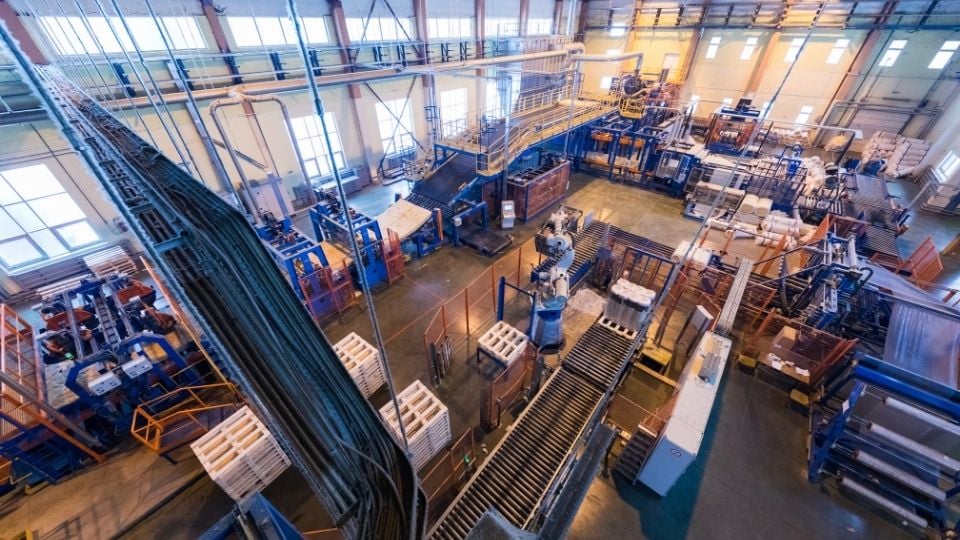How to improve operational performance?
| Written by Mark Buzinkay

No video selected
Select a video type in the sidebar.
Table of contents:
- What is Operational Efficiency?
- Optimise Processes to Enhance Efficiency
- Where Else Can You Improve Efficiency?
- Takeaway
- Glossary
Operational efficiency is the basis for the success of any business. That's why we should never stop improving it. Once you've done it successfully, it will make a difference to the scalability and profitability of your business. Every new day allows you to move your business forward from its current situation.
Learn more about how an RTLS solution can help improve operational performance.
As mentioned, you should never stop improving operational performance. It's easy to sit comfortably on your success and let things continue to run. However, if we want to pursue being ahead of competitors, it's essential to regularly review progress as it helps decide the following steps to improve operational excellence.
To back up this claim, let's look at a study published (1) claiming 77% of 1,300 global CEOs rely on operational efficiency to boost their revenue. The assumption is that heightened efficiency improves customer and employee satisfaction while increasing the bottom line by reducing operational issues and improving business processes.
Therefore, to enhance operational performance is a business-wide effort - from front to back-end processes, from distribution to marketing, from development to supply chain - a smooth workflow will limit the time and resources needed to run operations successfully. It's commonsense to trim costs, but it is not enough.
What is operational efficiency?
What is operational efficiency? Overall operational efficiency is the relationship between output and input. In other words, it is important to produce a high-quality product at scale with as few resources as possible. So, operational efficiency refers to the ability of an organisation to deliver the same with less, or when we are talking about productivity, we strive to do more with the same. So, for instance, a brownfield factory wants to achieve more output with the same resource, we would talk about increasing productivity.
Regarding operational efficiency strategies, businesses focus first on improving their operational efficiency before they look at how to increase productivity. Doing so will decrease the level of wasted effort and resources on the company's part. Once efficiency has been optimised, the organisation can take steps to improve productivity.
However, operational efficiency goes beyond cost management (read more about quality management and quality documentation). It creates a win-win scenario: optimal output for the company and a superior product for the customer. Enhancing operational efficiency requires consistent effort and a solid commitment to continuous learning, but it starts with processes. The accurate indicators of increased operational efficiency are intelligent resource allocation, more billable activities, and many other factors.

The key: Optimise processes to enhance operational efficiency
Improving operational efficiency starts with process refinement. So, where to start? Very often, process refinement is a delicate act. Therefore, it is essential to say that criticism should be welcome for it to be as close to quintessential as possible.
Process refinement
The first step in process refinement is always to analyse your performance. Once recorded data are available, you can use them as a reference point for future improvements and compare them (with your own in the past or against industry standards). However, you must decide on the most important metrics to evaluate the success of your organisation. Is it the satisfaction of your customers? Sales? Cost reduction? This can be tricky; every company needs to have a clear idea of the top metrics.
On a business-wide level, you want to identify the functions and goals within each department and understand their key players. The critical part of such an audit is to involve them in measuring how much time they need to execute their work to achieve their goals. During these observations, you will discover bottlenecks that make a process slower. Removing them is a step forward, but not the end yet. It is vital to eliminate any waste along this process. As you already have a reference point, now you can measure the results of your updated process and compare them. The quality of work done along the way mustn't be impaired. Everyone on the team should contribute their knowledge to improve operational efficiency. A dashboard showing records is a good idea.
Process refinement can be applied to all areas of a company. For example, in terms of operational performance improvement, these aspects of your business:
- Reducing procurement costs
- Optimising production
- Optimising distribution
- Optimising after-sales service
- Reducing overhead costs
- Optimising IT
- Reducing product complexity
- Reducing product costs
- Reducing working capital
- Optimising capital expenditure
We just described the core of enhancing operational efficiency in a few sentences, and it should be your foundation for dealing with the challenge. However, there are also some cross-industry ideas that can tackle some aspects of the problem. For instance, automating repeatable work is an excellent idea to look at. Many of us are bogged down by administrative duties repeated endlessly without producing any real value. Even repeatable core business processes can be automated, such as quoting, invoicing, project planning, proposal development, knowledge sharing, and financial reporting.
Learn more about RTLS and process optimisation.

Where else can you improve operational performance?
Provide regular training and share knowledge
Your staff need access to the best-practice methods. Having some workers trained on various systems and processes that they use or may use in the future will guarantee efficiency. Regular training is essential and beneficial for your operational performance and workplace culture: a mentoring or coaching program keeps everybody updated on the best practices for efficiency. In addition, promoting know-how sharing in formal and informal settings is critical. Another way to ensure that your employees are on the same page is to post documentation of such methods publicly. Training best practices include posting cheat sheets, documenting SOPs, and establishing a "coaching" methodology.
Discover and remove barriers to success
As mentioned above, perform process analysis to track problems and identify opportunities for improvements. Pareto charts help uncover extremes and determine where to make changes. This is not a "set-and-forget" mentality but an ongoing process.
Dealing with legacy systems migration? Then continue reading here...
Outsource IT tasks
IT development is not a core process in many businesses, but supporting them. Having your own IT team in-house, including IT equipment and software, can reduce your organisation's operational efficiency. Outsourcing your IT tasks is not always the way to go. It is affordable, enabling employees to focus on providing the expected results for your business. This also helps your business stay competitive since it boosts your customer satisfaction. This includes running operations via the cloud, especially for smaller companies because the overhead IT costs aren't affordable. Business owners can adopt cloud-based technologies to handle the progress of all of their projects, collaborate with the team when they're not in the office, and oversee the financial spectrum using various devices.
Streamline communications with your customers
Customers are not only important; they are the reason for your business. Therefore, excellent customer service plays a crucial role in your success. Thus, being knowledgeable about your customers is essential for your success and operational efficiency. To streamline communications and improve customer service, a customer service management system should be in place, offering an easy-to-use and user-friendly interface for your customers and where employees can assist them efficiently and quickly.
Check your workplace culture
Workplace culture can boost operational efficiency, so it's not wrong to look at it. Sharing knowledge, cooperating cross-functionally, and assisting each other to use synergies are good reasons to tap into it. As a start, employees should know the tools that may speed up their jobs and make their work easier. You can also implement procedures such as eliminating communication distractions, reducing unnecessary meetings, and lessening distracting digital notifications. You can also encourage productivity by rewarding the best employees with rewards.
Access to information
Every employee should be able to access crucial information, which is vital in improving operational efficiency. In addition, it enables the team to react to market changes quickly by providing everyone with accurate information.
Better order fulfilment
A growing business receives increasing order volumes. The right tools help fulfil its operations and meet changing demands. Companies should provide a framework for heightened productivity and efficiency, from routine maintenance to the implementation of advanced replenishment software (see also: PTL systems).
Set a high standard
After improvements have been implemented, updated standards should be used to promote efficiency and productivity. However, companies should incrementally increase expectations to improve workflow rather than using extreme measures that overwhelm employees.
Read more about the concept of Industry 4.0 smart factory...
takeaway
It is no secret that all businesses want to clamp down on costs. However, improving operational performance is more than that; it is not a one-and-done initiative. It is a combined effort to optimise processes, people, financials, and technology. Eventually, the financial viability of projects and services depends on the balance of all elements and is the result of continuous improvement. Improving operational efficiency within an organisation requires identifying waste areas and improving efficiency. Then, management can focus on making the most of those resources to increase productivity. RTLS may help to improve your operational performance - download our 101 RTLS guide!
Continue reading the complete overview: Real time location systems in manufacturing and indoor logistics
Glossary
Outsourcing is the business practice of delegating specific tasks, functions, or services to external companies or third-party providers instead of handling them in-house. It is commonly used to reduce costs, improve efficiency, and access specialized expertise. Businesses outsource various activities such as IT services, customer support, manufacturing, and accounting. While outsourcing offers benefits like cost savings and flexibility, it can also pose risks related to quality control, security, and dependency on external vendors.
Sources:
(2) Kremic, T., Tukel, O. I., & Rom, W. O. (2006). Outsourcing decision support: A survey of benefits, risks, and decision factors. Supply Chain Management: An International Journal, 11(6), 467-482.
Note: The article was updated on the 31st of July, 2025. This article was partly created with the assistance of artificial intelligence to support drafting.

Author
Mark Buzinkay, Head of Marketing
Mark Buzinkay holds a PhD in Virtual Anthropology, a Master in Business Administration (Telecommunications Mgmt), a Master of Science in Information Management and a Master of Arts in History, Sociology and Philosophy. Mark spent most of his professional career developing and creating business ideas - from a marketing, organisational and process point of view. He is fascinated by the digital transformation of industries, especially manufacturing and logistics. Mark writes mainly about Industry 4.0, maritime logistics, process and change management, innovations onshore and offshore, and the digital transformation in general.
Related Articles
Related Product





